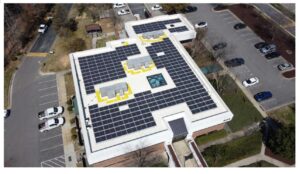22 Apr Solar Energy Helping Fuel OWASA Water and Wastewater Services
OWASA has installed solar arrays to offset some energy costs associated with providing water and wastewater services to customers.

Solar array on Administration Building on OWASA campus.
To the passerby, the OWASA campus at 400 Jones Ferry Road looks much like it always has, but to Strategic Initiatives Manager Mary Tiger it elicits a feeling of pride. Not because of what’s inside the buildings, but because of what’s on top of them.
Supported by the leadership of the OWASA Board of Directors, OWASA has worked with Eagle Solar and Light to install a 100kW DC solar array on the top of the Administration Building and a 60kW DC system atop the Operations Center. A 150kW DC ground mount system has also been installed at the OWASA Biosolids facility.
“The energy generated by the solar panels offsets energy used by our facilities, reducing our Duke Energy bills and our greenhouse gas emissions for years to come,” says Tiger. The solar panels will deliver clean renewable power for over 25 years.
In 2021, OWASA’s solar PV systems generated over 258,000 kWh (1.1% of our 2010 baseline energy use) and saved OWASA over $20,000 in purchased power from Duke Energy. The savings were greater than the $19,102 in lease payments made for the systems. With a full year of production from these three systems, we anticipate that they will generate over 420,000 kWh of renewable energy in 2022.
Now, Chapel Hill and Carrboro residents have one more reason to feel a sense of pride in their community: OWASA broke ground on our fourth – and largest – solar array at Cane Creek Reservoir this week, just in time for Earth Day. When this PV system connects to the grid, OWASA will achieve its Energy Management Plan goal to reduce purchased electricity by 35% from a 2010 baseline. This 350kW DC project will produce over 524,400kWh of renewable energy in its first year of operation, which represents about 2.3% of OWASA’s 2010 energy use. Like all OWASA’s solar arrays, this project will provide a cost benefit (or at least break even) to OWASA ratepayers starting in year one.
But, these projects mean more than just financial savings. When you consider the social cost of carbon, over their lifetime, these four projects will save an estimated $300,000 in reduced damages caused by carbon emissions over the life of the panels. That means cleaner air, better health outcomes – especially for low-income households, less property damage, and lower food prices. That’s something we can all be proud of.
These projects were made possible thanks to solar rebates from Duke Energy and a $75,000 grant from the Orange County Climate Action Fund.



